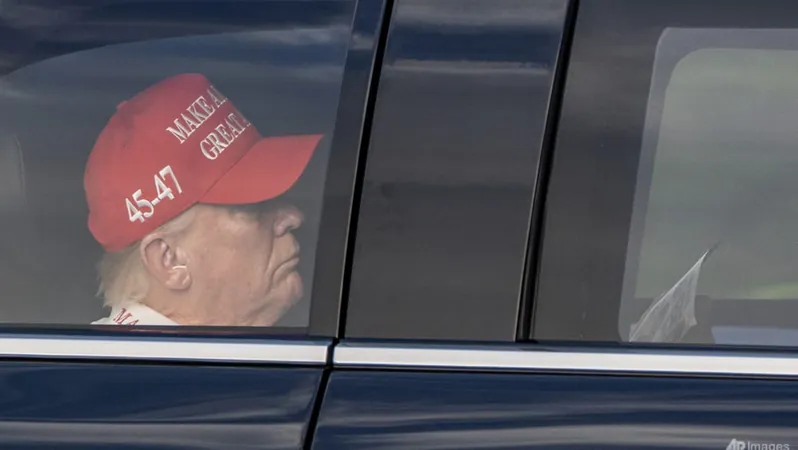
Trump's Tariff Tactics: Will the Economic Revolution Lead to Victory or Trade Wars?
2025-04-05
Author: John Tan
In a bold move that could reshape the global economic landscape, US President Donald Trump reaffirmed his commitment to implementing sweeping tariffs against various countries during a recent address. He candidly warned Americans to prepare for potential hardship but optimistically predicted historic investment and prosperity in the long run.
As the first wave of tariffs went into effect, Trump took to his Truth Social platform, declaring, "We have been the dumb and helpless 'whipping post', but not any longer. We are bringing back jobs and businesses like never before." He characterized this moment as an "economic revolution," urging his supporters to "hang tough" despite the inevitable challenges ahead: "It won't be easy, but the end result will be historic."
Starting from April 5, a 10 percent "baseline" tariff has been introduced, impacting most US imports with the exception of goods from Canada and Mexico. The White House attributed these trade deficits to a lack of reciprocity in trade relationships and unfair practices, including what they term "exorbitant value-added taxes” imposed by other countries.
The unrest doesn't end there. On April 9, approximately 60 trading partners—spanning the European Union, Japan, and China—will confront even steeper tariffs, uniquely tailored to each economy’s exports. Notably, the anticipated 34 percent tariff on Chinese goods, set to activate soon after, has already incited Beijing to retaliate with a matching tariff on American products, which will commence on April 10. Additionally, China plans to take the situation to the World Trade Organization (WTO) and restrict exports of rare earth elements critical for high-tech industries.
Trump was quick to defend his stance, asserting, "China has been hit much harder than the USA, not even close. They, and many other nations, have treated us unsustainably badly." However, this bullish rhetoric does come against a backdrop of caution, as other significant trading partners evaluate their next moves, wary of an impending recession.
MARKETS REEL UNDER PRESSURE
Markets are feeling the heat. Wall Street suffered a notable downturn following similar declines in Asian and European markets. Economic experts have expressed concerns that the increasing tariffs may stifle economic growth while simultaneously stoking inflation.
Interestingly, some goods will remain exempt from these tariffs, including copper, pharmaceuticals, semiconductors, and lumber, primarily because separate tariff measures are already in place. Nonetheless, Trump has initiated investigations into copper and lumber imports, paving the way for potential future duties in these areas.
While Canada and Mexico are currently shielded from these latest tariff adjustments due to existing quotas related to the North American trade agreement, the threat of further repercussions looms large.
RETRIBUTION ON THE HORIZON?
As Trump's phased tariff implementation gives room for negotiations, analysts predict that failure to secure exemptions will likely result in retaliatory actions from affected countries. Maros Sefcovic, the EU trade chief, emphasized a careful and coordinated European response to these tariffs, although he made it clear that the EU “won't stand idly by.” Countries such as France and Germany have hinted at possible taxation on US tech companies in retaliation.
Japan's Prime Minister has advocated for a measured approach following the announcement of tariffs on Japanese products, while Trump recently claimed a “very productive” discussion with Vietnam’s leadership, even as that nation faces staggering 46 percent duties.
As the tariff landscape evolves, history echoes with caution. Trump's latest global levies, described by experts as the most extensive since the Smoot-Hawley Tariff Act of 1930, could lead to a chain reaction reminiscent of the trade wars that once deepened the Great Depression. According to Oxford Economics, the implementation of these tariffs could elevate the average effective US tariff rate to an astounding 24 percent—surpassing even the levels seen during the Great Depression.
Only time will reveal whether Trump's ambitious tariffs will cultivate an economic renaissance or spiral into a daunting trade war. As tensions brew, one question remains: How will American consumers and businesses navigate these turbulent waters? Stay tuned for more updates on this unfolding saga.



 Brasil (PT)
Brasil (PT)
 Canada (EN)
Canada (EN)
 Chile (ES)
Chile (ES)
 Česko (CS)
Česko (CS)
 대한민국 (KO)
대한민국 (KO)
 España (ES)
España (ES)
 France (FR)
France (FR)
 Hong Kong (EN)
Hong Kong (EN)
 Italia (IT)
Italia (IT)
 日本 (JA)
日本 (JA)
 Magyarország (HU)
Magyarország (HU)
 Norge (NO)
Norge (NO)
 Polska (PL)
Polska (PL)
 Schweiz (DE)
Schweiz (DE)
 Singapore (EN)
Singapore (EN)
 Sverige (SV)
Sverige (SV)
 Suomi (FI)
Suomi (FI)
 Türkiye (TR)
Türkiye (TR)
 الإمارات العربية المتحدة (AR)
الإمارات العربية المتحدة (AR)